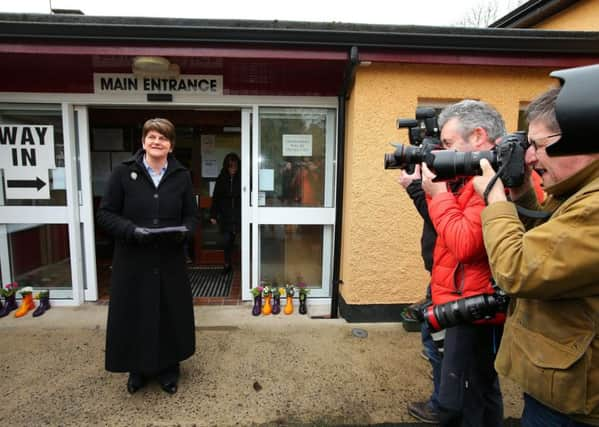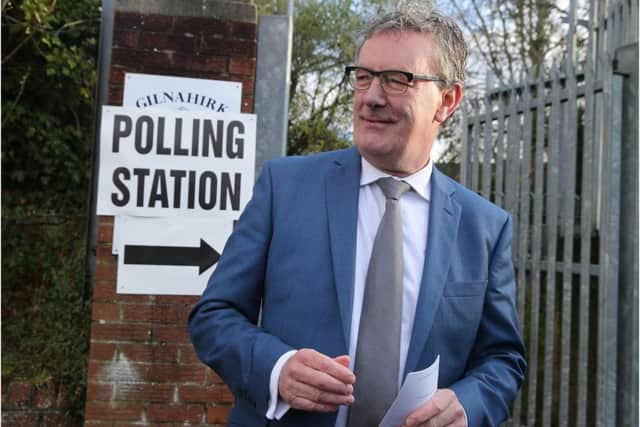Assembly Election: Nervous wait for candidates as turnout rises in many areas


After a snap election which few people had been pressing for just 10 months after the last Assembly election, some pundits had feared another very poor turnout.
However, from early on anecdotal stories of queues to vote began to emerge from various constituencies. By tea time, as 5pm turnout figures were posting up in polling stations across the Province, that sense of increased interest was backed up by the data.
Advertisement
Hide AdAdvertisement
Hide AdThen, as turnout figures were put up in polling stations at 9pm, just an hour before closing time, it became clear that there was a significantly increased turnout in many polling stations.


There were still a few very low turnouts. But the more common story emerging from reports across the Province was of turnouts well in excess of the average last time – 55% – and some turnouts at polling stations in leafy parts of south and east Belfast up about ten percentage points on last year.
It now seems clear that the significantly bigger UTV (+42%) & BBC (+75%) viewing figures for the leaders’ debates were an indication of public mood and have followed through into voting patterns.
However, it will not be clear until counting gets under way today whether that mood has primarily been driven by the RHI scandal or by what Peter Robinson has referred to as this election’s “constitutional importance” to Northern Ireland.
Advertisement
Hide AdAdvertisement
Hide AdAt first glance, turnouts appeared to be particularly strong in middle class parts of the east of Northern Ireland – where Alliance and the Greens could expect to do well – and in rural nationalist areas where Sinn Fein is the dominant political force.


Among some of the interesting stories to emerge tonight were:
• An increase on an already exceptionally high turnout in Arlene Foster’s home polling station of Brookborough, up from a final turnout of 77.4% last year to a final turnout of 81.3%.
• A significant increase in turnout at Cooke Centenary Church on the Ormeau Road in South Belfast – up from a 9pm turnout of 48% last year to a 9pm turnout of 58% yesterday.
Advertisement
Hide AdAdvertisement
Hide Ad• Turnout up from 53% to 62% at 9pm at Euston Street in East Belfast.
• A report of a turnout of 83% at 9pm at a ballot box in the border town of Aughnacloy in Fermanagh South Tyrone; but in an indication that the issue of Brexit was not driving higher turnouts across the board in border areas the final turnout in some Strabane boxes was less than 65%.
• As is traditional, there were some very high rural turnouts in the west of the Province. Former victims’ commissioner Patricia MacBride reported a turnout of over 80% at her Draperstown (Mid Ulster) polling station and having to “squash down ballots to get my vote in” to the ballot box.
• Reports of a 9pm turnout of 74% in Mountfield in West Tyrone – up from 60% last year – and of a 75% turnout at 9pm in Annaghmore’s Ochard County Primary School in the north of Newry and Armagh.
Advertisement
Hide AdAdvertisement
Hide Ad• A significantly increased 5pm turnout in Castledawson (Mid Ulster) of 48.7% – considerably higher than the 28.5% in last year’s Assembly election and the 30.1% in the EU referendum.
As the post-election bloodletting began even before a ballot box had been opened, last night former DUP MLA David McIlveen – who remains a party member, though now an open critic of the leadership – told BBC programme The View that last year’s election had been the “last chance saloon” for the DUP and that this was an election DUP “couldn’t afford to fight”
Mr McIlveen denounced both unionist leaders, describing them as possessing “as much charisma as in a piece of tofu”. The former North Antrim MLA said he did not believe that Mrs Foster would still be DUP leader on Monday.
And former Sinn Fein MLA Daithi McKay told the same programme that Arlene Foster had – in her attempt to get the DUP’s vote out, despite the RHI scandal – “motivated and reawakened a dormant nationalist vote”.
Advertisement
Hide AdAdvertisement
Hide AdCounting will begin this morning after the verification of ballots. The increased turnout may contribute to a slightly slower count than last year, although there are fewer candidates standing and only five, rather than six, seat to fill in each constituency.
The count is scheduled to run into Saturday although deputy returning officers can agree with candidates to count into the night if it appears that the count can be completed.